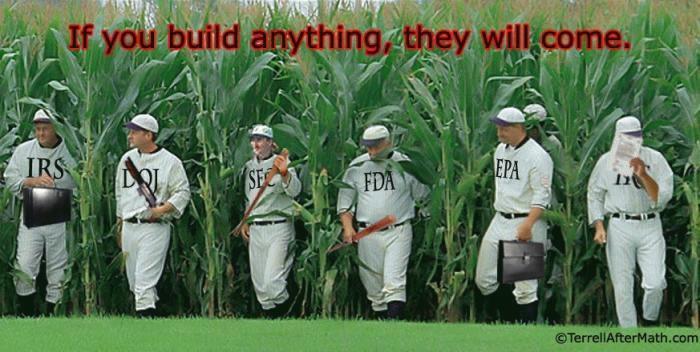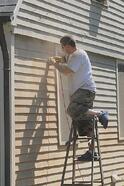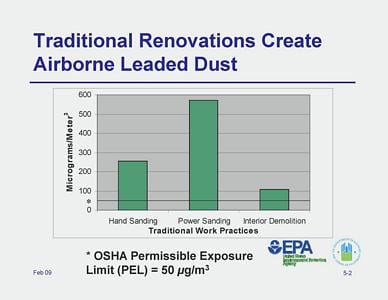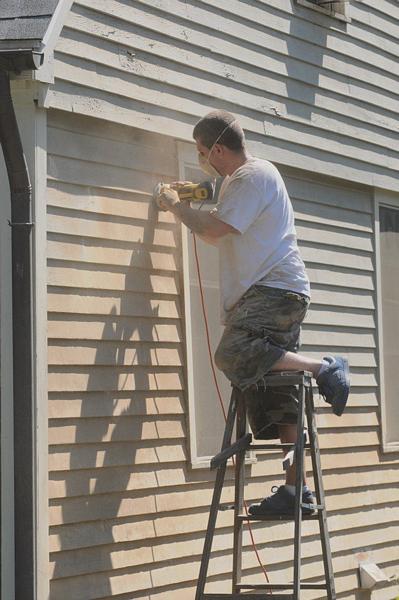
Renovators Intending to Comply With EPA RRP Rule May Be Blind-Sided by OSHA Requirements
The following article, written by Dick Hughes of Excellence In Safety, was forwarded to me last week by a colleague. Dick credits his sources at the end of the article. I also verified the accuracy of the information through one of my contacts at the Massachusetts DOS.

The article lists a variety of OSHA considerations that may likely blind-side well intentioned renovators as they attempt to comply with the new EPA RRP Rule. The RRP Rule and OSHA requirements are in conflict with each other in many ways. One EPA contact shared with me that EPA and OSHA did not collaborate on the rule while it was being written. This one consideration alone should raise serious doubt and concern for business owners about business liabilities and potential fines.
 If an EPA enforcement employee and and OSHA Field inspector show up at one of your jobsites, at the same time, there is no way you will be able to satisfy both. I suggest this is another example of shortsighted leadership within both organizations. It also points out the lack of knowledge and awareness our political leaders in Congress have as it relates to understanding the construction industry and overseeing the creation of regulations that affect businesses of all sizes.
If an EPA enforcement employee and and OSHA Field inspector show up at one of your jobsites, at the same time, there is no way you will be able to satisfy both. I suggest this is another example of shortsighted leadership within both organizations. It also points out the lack of knowledge and awareness our political leaders in Congress have as it relates to understanding the construction industry and overseeing the creation of regulations that affect businesses of all sizes.
The Article:
Big Compliance Problems Ahead for Worker Safety
On April 22, 2010, the Environmental Protection Agency (EPA) implemented a rule that requires contractors that are hired to perform renovation, repair and painting (RRP) projects in homes, child care facilities, and schools built before 1978 that disturb lead-based paint to be certified and follow specific work practices to prevent lead contamination. This rule is expected to impact hundreds of thousands of employers and millions of employees.
EPA is already proposing an expansion of this rule into pre-1978 commercial facilities. That change will significantly expand the scope of employers and building owners covered by this new regulation. Failure to comply with this new regulation can result in fines as high as $65,000 per violation, including a potential prison term. The EPA will enforce violations of the new regulation starting on Oct. 1, 2010.
The new EPA rule includes the following requirements:
• The new EPA regulations require “firms” that disturb more than 6 square feet of paint per room (or more that 20 square feet on the exterior) in these pre-1978 buildings to become certified with the EPA and employ certified renovators who would train workers and oversee these projects.
• Firms include contractors who are hired to perform renovation, repair and painting work where paint is disturbed in the targeted housing.
• Building owners whose maintenance staff also disturb painted surfaces in targeted housing must also be certified and use certified renovators.
• Certified firms must send a supervisor or “renovator” to an 8-hour class where they become certified to oversee work covered by the RRP rule.
Here’s the rub: The 8-hour class only covers the EPA requirements and completely ignores OSHA worker protection rules. Therefore, safety professionals might find that “Certified Firms” are violating OSHA lead regulations because they were not taught about OSHA requirements for worker protection. This is going to be a huge issue for employers whose employees are exposed to lead hazards during work covered by the new EPA RRP rule.
EPA Rule Doesn’t Fulfill OSHA Requirements
Employers and building owners should be alert to the fact that OSHA rules differ significantly from the EPA RRP regulations. OSHA lead regulations apply to any work where employees come into contact with any level of lead or lead bearing coatings. They should also note the following worker protection and/or OSHA omissions in the new EPA lead-based paint rule:
• Lead-based paint. The EPA RRP rule defines lead-based paint as containing more than 0.5 percent lead by weight. Lead coatings below this threshold are exempt from any special EPA certification, training or work practices. However, OSHA regulates lead in any amount. Therefore, many employers will believe that lead-coated surfaces below the EPA standards of 0.5 percent by weight are not regulated when in fact they may still be regulated by OSHA.
• Regulated areas.OSHA mandates under 1926.62 that employers establish “regulated areas” when lead or lead-coated surfaces are disturbed. A regulated area requires specific OSHA signage. The EPA signs required by their new RRP rule do not meet OSHA requirements for a regulated area.
• Written compliance program. OSHA regulations require a detailed compliance program listing specific requirements for employers to document. The EPA RRP rule does not have any requirements or discussion of a written compliance plan.
• Mandatory respirator use. OSHA lead regulations require monitoring for employees exposed to lead dust or fumes during work. OSHA has established three work class tasks for which certain exposures above the permissible exposure limit (PEL) must be assumed when employers fail to perform exposure monitoring. All of the work practices covered by the EPA RRP rule require employee respiratory protection under OSHA. However, the EPA required training only discusses respirator use as optional. The EPA training does not discuss OSHA regulations for a written respirator program, medical clearance, respirator training and fit testing for employees who are required to wear respirators.
• Protective clothing. OSHA lead regulations require protective clothing when work tasks disturb lead coatings (without a negative exposure assessment). OSHA requires either disposable clothing or employer laundering. The EPA RRP rule lists disposable clothing as optional and trains workers to use HEPA vacuums to clean clothing before going home. OSHA also requires employers to notify other employees or employers who would launder the contaminated clothing. The EPA RRP rules do not provide any awareness for employees who launder their own contaminated work clothing.
• Annual training. OSHA regulations require annual training when airborne levels of lead dust or fumes exceed their action level. EPA’s new RRP rule only requires training every 5 years.
• Hygiene facilities. OSHA regulations require a separate area to change from work clothing to street clothing as well as providing for hand/face washing facilities. The EPA does not address change facilities and suggests that workers wash their hands and face prior to leaving the work place.
• Medical surveillance and biological monitoring. OSHA mandates biological monitoring for employees exposed above the action level for airborne lead dust and fumes. The EPA RRP rule briefly mentions that the only way to detect lead in your blood is with a blood test and does not inform the workers of the OSHA requirement for biological monitoring.
The new EPA RRP lead-based paint rule is an important regulation for reducing the unacceptable levels of elevated lead in children’s blood in certain areas of the country. However, this huge piece of legislation has done a disservice to the millions of workers who will be impacted by lead during common renovation, repair, and painting activities in residential and child occupied facilities by ignoring mandatory worker protection requirements mandated by OSHA. Contractors and building owners must take extra steps to ensure that their workers or employees of contractors disturbing lead bearing substances in their facilities are thoroughly trained and protected in all applicable regulations; specifically OSHA worker protection rules for lead.
Thanks to:
Jeffery C. Camplin, MS, CSP is president of Camplin Environmental Services Inc., a safety and environmental consulting firm based in Rosemont, Ill. He is a licensed lead risk assessor and accredited EPA lead-based paint instructor for abatement courses and the new RRP rule training.
Useful links related to this article:
• July 21 Virtual Audioconference: EPA’s New Lead Paint Regulations Will Get You in Trouble with OSHA http://www.workplacetrainingcenter.com/Prod-2067.aspx
• EPA information on the new RRP rule for lead-based paint can be found at http://www.epa.gov/lead/pubs/toolkits.htm
• HUD information on lead safe work practices for renovation work can be found at http://www.hud.gov/offices/lead/training/rrp/rrp.cfm
• OSHA information on worker protection for employees exposed to lead-bearing substances can be found at http://www.osha.gov/SLTC/lead/construction.html
About the author:
Dick Hughes
Excellence In Safety
24 Spring Bars Road Falmouth, MA 02540
Web: www.excel-in-safety.com
capesafetyguy@aol.com
1-508-548-0866
cell: 1-617-653-4950
This article was originally published at Work Place Magazine

 With spring only a short time away, contractors will soon be working outdoors again in the northeast. This will make the work they do and the work practices they use much more visible to OSHA and EPA. Consider yourself warned and get ready. In additional to the work practices required under RRP rules, there are plenty of OSHA regulations and requirements as well. If you don’t have written safety plans for the work your business performs, or if you have not provided the required safety training and equipment for your workers, you might become an easy target.
With spring only a short time away, contractors will soon be working outdoors again in the northeast. This will make the work they do and the work practices they use much more visible to OSHA and EPA. Consider yourself warned and get ready. In additional to the work practices required under RRP rules, there are plenty of OSHA regulations and requirements as well. If you don’t have written safety plans for the work your business performs, or if you have not provided the required safety training and equipment for your workers, you might become an easy target. 
 Looking for accurate information about the EPA RRP rule?
Looking for accurate information about the EPA RRP rule?  Anne points out that EPA Administrator Lisa was quoted to say “EPA is back on the job" and that EPA has received the largest enforcement budget in its history, making it more likely that your business will be subject to some type of investigation.
Anne points out that EPA Administrator Lisa was quoted to say “EPA is back on the job" and that EPA has received the largest enforcement budget in its history, making it more likely that your business will be subject to some type of investigation.  Although a written request for information should specify the statutory authority for the request, don't assume that the agency actually has the cited authority. Knowing the source of the government's authority for the request, as well as determining the applicability of the request to your business, is imperative in both limiting the scope of your response and protecting your business interests with customers and other parties that may be affected by the request.
Although a written request for information should specify the statutory authority for the request, don't assume that the agency actually has the cited authority. Knowing the source of the government's authority for the request, as well as determining the applicability of the request to your business, is imperative in both limiting the scope of your response and protecting your business interests with customers and other parties that may be affected by the request. On the other hand, since taking over the RRP Rule in MA, working with MA state officials has been much more productive. The Massachusetts Department of Labor Standards (DLS), formally called the Massachusetts Division of Occupational Safety, under the leadership of the department's Director Heather Rowe, has been very receptive to meeting with concerned stakeholders, hearing and recognizing stakeholder's concerns, and working with stakeholders to address their concerns. Currently, in addition to working on amendments to the RRP regulations in MA to address concerns, the DLS is also finalizing their plans to step up enforcement and compliance actions this spring as the home improvement season begins. Is it happening as fast as we all might like, no. However, based on budget and resource realities, I think DLS is doing a good job listening and prioritizing their efforts.
On the other hand, since taking over the RRP Rule in MA, working with MA state officials has been much more productive. The Massachusetts Department of Labor Standards (DLS), formally called the Massachusetts Division of Occupational Safety, under the leadership of the department's Director Heather Rowe, has been very receptive to meeting with concerned stakeholders, hearing and recognizing stakeholder's concerns, and working with stakeholders to address their concerns. Currently, in addition to working on amendments to the RRP regulations in MA to address concerns, the DLS is also finalizing their plans to step up enforcement and compliance actions this spring as the home improvement season begins. Is it happening as fast as we all might like, no. However, based on budget and resource realities, I think DLS is doing a good job listening and prioritizing their efforts. As one way to continue their efforts and interact with stakeholders, the Massachusetts Department of Labor Standards is looking for additional input from contractors and lead industry practitioners in anticipation of making amendments to the MA RRP regulations. An official from this agency will be participating in a May 18 workshop on the RRP Rule being held in Marlborough, MA sponsored by the Lead and Environmental Hazards Association (LEHA) and will be discussing the Department’s plans for revising the RRP regulations as well as the Department's enforcement efforts.
As one way to continue their efforts and interact with stakeholders, the Massachusetts Department of Labor Standards is looking for additional input from contractors and lead industry practitioners in anticipation of making amendments to the MA RRP regulations. An official from this agency will be participating in a May 18 workshop on the RRP Rule being held in Marlborough, MA sponsored by the Lead and Environmental Hazards Association (LEHA) and will be discussing the Department’s plans for revising the RRP regulations as well as the Department's enforcement efforts. While at the workshop I found one thing the main instructor Darcy Cook of Safety Trainers said to be very important for contractors to be aware of. Under the OSHA Lead in Construction Standard, contractors must assume their employees will be exposed to lead above OSHA’s established action level requiring the use of respirators until they actually conduct air monitoring testing to prove otherwise.
While at the workshop I found one thing the main instructor Darcy Cook of Safety Trainers said to be very important for contractors to be aware of. Under the OSHA Lead in Construction Standard, contractors must assume their employees will be exposed to lead above OSHA’s established action level requiring the use of respirators until they actually conduct air monitoring testing to prove otherwise.
 So, under OSHA requirements, before allowing them to do RRP related work or even enter a contained work area, employees must first be sent to a physician to be sure they are healthy enough to wear a respirator. Then they must be fit tested by a professional and provided with a properly fitted respirator that protects them from worst case lead exposure scenarios based on the kind of work they do. They must also be trained how to select, use, clean and store a respirator. And, they must wear the respirator until the air monitoring testing is done to identify when a respirator is required and when it is not depending on how the work is performed and what engineering controls are being used.
So, under OSHA requirements, before allowing them to do RRP related work or even enter a contained work area, employees must first be sent to a physician to be sure they are healthy enough to wear a respirator. Then they must be fit tested by a professional and provided with a properly fitted respirator that protects them from worst case lead exposure scenarios based on the kind of work they do. They must also be trained how to select, use, clean and store a respirator. And, they must wear the respirator until the air monitoring testing is done to identify when a respirator is required and when it is not depending on how the work is performed and what engineering controls are being used.


 On Friday
On Friday  If RRP instructors follow the EPA created instructor training manual when training renovators, they will be teaching students to do things that violate OSHA rules. (
If RRP instructors follow the EPA created instructor training manual when training renovators, they will be teaching students to do things that violate OSHA rules. ( Current OSHA and RRP related rules and training seems to concentrate on what not to do, without enough time and attention on the right way to do things. With OSHA for example, fall protection rules require a business to put fall protection equipment in place and train workers when and how to use. Great, but why not also complement it with training on methods for working safely and how to avoid putting yourself in a position to fall?
Current OSHA and RRP related rules and training seems to concentrate on what not to do, without enough time and attention on the right way to do things. With OSHA for example, fall protection rules require a business to put fall protection equipment in place and train workers when and how to use. Great, but why not also complement it with training on methods for working safely and how to avoid putting yourself in a position to fall?  For RRP, the required training teaches how to contain dust and debris so it won’t spread outside the contained work area. Might renovators who follow these instructions only be increasing the health risks to workers by containing and concentrating the dust and debris in the confined work area? Wouldn’t it make sense to also train workers on lead-safe work practices that actually limit or prevent the creation of dust to begin with?
For RRP, the required training teaches how to contain dust and debris so it won’t spread outside the contained work area. Might renovators who follow these instructions only be increasing the health risks to workers by containing and concentrating the dust and debris in the confined work area? Wouldn’t it make sense to also train workers on lead-safe work practices that actually limit or prevent the creation of dust to begin with? 

 If an EPA enforcement employee and and OSHA Field inspector show up at one of your jobsites, at the same time, there is no way you will be able to satisfy both. I suggest this is another example of shortsighted leadership within both organizations. It also points out the lack of knowledge and awareness our political leaders in Congress have as it relates to understanding the construction industry and overseeing the creation of regulations that affect businesses of all sizes.
If an EPA enforcement employee and and OSHA Field inspector show up at one of your jobsites, at the same time, there is no way you will be able to satisfy both. I suggest this is another example of shortsighted leadership within both organizations. It also points out the lack of knowledge and awareness our political leaders in Congress have as it relates to understanding the construction industry and overseeing the creation of regulations that affect businesses of all sizes.


